It’s been a bit over a month since Tacx first announced the Flux S, which despite looking similar at a distance to the also newly announced Flux 2, is indeed different. Aside from price (the Flux S is $749USD and the Flux 2 is $899), the Flux S is slightly lesser spec’d than the Flux 2. Effectively it’s a minor refresh of the original Flux from two years ago.
Of course, we’ll get to all the technical details in a bit. Lots of details. From how well it handles to accuracy and sound and plenty more. I even got to test out not one, but two different Flux S units for accuracy…among other things.
If you just want to grab a cup of coffee and sit back and press play – then you can do so with the below video I put together summarizing everything. Plus, where else do you get to see 800+ people riding a Zwift event together (without having to do the work)?

And finally, as usual the Flux S is a media loaner and will go back to Tacx shortly. Maybe I’ll even put it in my cargo bike and pedal it over to them myself. We’ll see if I have that much spare energy. Probably not. A delivery truck works fine too.
Onwards with the review!
Technical Overview:
The basic concept of the Tacx Flux S is to essentially take the existing Flux trainer that’s had a pile of internal changes over the past two years, tweak the frame to allow longer derailleur cages…and call it a new trainer (oh, and they dropped the price by some $150). Meanwhile, they also announced the Tacx Flux 2, which takes many of those same internal changes but adds a pile of additional gusto to make a more powerful trainer and left that at the original price of $899.
The Flux S is no more quiet than the original Flux, it’s also not really any more powerful either. Most all of the changes internally have been focused on manufacturing rather than features. Still, some things spill into the feature realm. Here’s the specific list of items that have been changed:
– Improved internal tension roller: which results in slightly improved road feel and accuracy during sprints
– Improved internal alignment: Nothing meaningful to consumers, purely manufacturing
– Long derailleur cage support: They dropped the legs lower so that it fits
But before we get too far, let’s do a quick dive into the core tech specs in a bulleted fashion:
– Direct drive trainer: This means you remove your rear wheel
– Flywheel: It has a 6.7kg flywheel (but simulates 25KG)
– Cassette: No Tacx trainers include a cassette, which will set you back $50-$60, plus $10-$20 in tools to install.
– Sound: It’s essentially the same as the original Flux (and the Flux 2), quiet-ish, but definitely not mostly silent like the Tacx Neo or Wahoo KICKR CORE.
– Handle: This unit lacks a handle, which continues to be a bit of an oddity compared to other brands.
– Protocol Compatibility: ANT+ FE-C, ANT+ Power, Bluetooth Smart Trainer Control, Bluetooth Smart Power
– App Compatibility: Every app out there basically (Zwift, TrainerRoad, Rouvy, Road Grand Tours, SufferFest, Kinomap, etc…)
– Compatibility: 130/135 QR in-box. Also compatible with 12×142 & 12×148 Thru-Axle, but only with a not-included adapter (the Flux 2 includes the adapters inbox)
– Max Incline: 10% simulated grade
– Max Wattage: 1,500 watts resistance
– Stated Accuracy: +/- 3% (the Flux 2 is +/- 2.5%)
– Pricing and Availability: $749/€599, already shipping as of this week.
For comparison, here’s the price/feature points of some of the Tacx 2018 Trainer lineup (they have a pile of other trainers, these are the ones I’m considering most interesting/relevant):
Tacx Flow Smart – 299EUR: Wheel-on trainer with 6% incline, all standards supported.
Tacx Bushido Smart – $619: Wheel-on trainer with 15% incline, all standards supported.
Tacx Flux S Smart – $749: Direct drive trainer with 10% incline capability, no cassette included
Tacx Flux 2 Smart – $899: Direct drive trainer with 16% incline and better low-speed resistance for climbs, no cassette included
Tacx Neo Smart – $1,369: Top of the line direct drive trainer that’s virtually silent, can replicate road vibrations too, no cassette included
Tacx Neo Bike Smart – $3,199: A full indoor bike built atop the Neo. Nifty fans included too.
Oh, with that out of the way let’s get into the details of setup and configuration…which won’t take too long. This is one of the easiest to assemble direct drive trainers as it requires a mere two bolts to two connect two parts together.
What’s in the box:
Trainer companies are really stepping up their games lately when it comes to the unboxing process of trainers. And I’m mostly talking non-Wahoo companies, since up till recently Wahoo trainers came totally pre-assembled, just pull them from the box and you’re good to go. I hate spending a pile of time sitting on the ground playing Jenga with new trainers.
While the Tacx Flux S technically is in two pieces, it’s silly easy to assemble (as you might have seen in the video above). But first, the box:
Inside it, you’ll find the main body of the trainer, the legs (as one piece), two bolts, two washers, and a hex wrench. Also, there’s a sturdy quick release skewer and a spacer for 9-speed cassettes. And some paper stuff.
To assemble things simply take the singular leg/foot and attach it to the trainer in one swift motion (not Zwift motion, that’s different). Then, using your fingers just thread the bolts in. After they get to the point your fingers wimp out, use the included hex wrench.
The entire process takes under 30 seconds, unless you’re trying to photograph it properly, in which case you might be talking at least 45-48 seconds.
You’re done.
Actually, technically you have to slide that skewer through there. Then you’re done. Oh, and install the cassette – but we’ll save that for a later section. This is the unboxing section after all, and things have already spiraled out of control to having the unit nearly completely built. Well, minus that cassette. After all – like most trainers there’s not one included.
Finally, I need to note that I actually had two Flux S units. As those who watched the video above saw/heard, the first unit I unboxed and rode worked technically just fine. Accuracy was spot-on and all (without even a calibration). Except there was an odd rubbing sound inside of it from the first pedal stroke onwards. After contacting Tacx about it they swapped out the unit immediately and took it apart. The odd-duck sounding unit apparently had extra plastic on one part that was rubbing against the flywheel, causing the sound heard in the video.
The new unit does not have that issue. Tacx says they’ve put in place a system to double-check that specific item on all units going forward, and have checked all other units. Still, this will no doubt remind folks of the quality control issues that Tacx had with the original Flux two years ago. Obviously, much of what Tacx put into place for the Flux S is designed to mitigate those issues (especially since this is basically just a re-branded original Flux). So this could well have been a 1 in 10,000 fluke that I got one that slipped through. I (nor you) don’t really know. We’ll just have to wait and find out over time.
The Basics:
Once the base installation is together there actually is one bit that will take a minute or two – which is installing the cassette. As noted it doesn’t include a cassette, so you’ll need to pick one up. I typically buy Shimano Ultegra cassettes for my trainers (mostly for sound-testing consistency across videos), but I’ve also done a few SRAM ones and whatever else happens to be on sale from the bike shop. It generally doesn’t matter, except sometimes you’ll find some of the lower end cassettes (like a Shimano 105) don’t quite sound as quiet as mid to higher end ones.
In any case, with a cassette, you’ll need two tools. A lockring tool (or lockring + a wrench, in my case), and a chain whip. In this case you need the chainwhip since you can’t get a good grasp on the flywheel. Whereas for a trainer like a KICKR, you can simply hold the flywheel to get the opposite tension you need.
After sliding the cassette on, just validate it doesn’t wiggle any. If it wiggles, then something is amiss (either it’s not tightened properly or if on a 9/10 speed cassette then a spacer is likely missing).
And with that – installation is complete:
Oh, technically you should plug it in. It does need power (110-240v) to provide any meaningful resistance. Some of you have asked about that awesome tower of power in the background on past posts that I bought. It accepts any international outlet type, super useful for those in Europe (EU/UK link here, and a variant of the same thing for US folks here). Plus has four USB ports for charging pedals on power meters and such.
Once plugged in you’ve got three individual status lights. One is for general power (green), the next for Bluetooth Smart connectivity (Blue), and the last for ANT+ connectivity (red).
Note that there’s no foldable legs on the Tacx Flux series, nor any handle. This does make it cumbersome to move around, since you basically have to give it a bear hug.
Once you’ve got the trainer ready, you’ll attach your bike to it using the included trainer skewer:
As noted, the trainer isn’t silent. It’s kinda got a bit of a low-growl noise to it. Not loud, and thankfully not high pitched. You can hear it within the overview video linked at the start of the post. The only trainer in the Tacx lineup that’s silent is the Tacx Neo (minus drive-train noise of course). You can hear the noise within my video about half-way through.
Next, while Tacx does have a mobile app for their trainer, it’s unlikely you’re going to use it much if you use other 3rd party software. However, it is valuable for setting your correct weight so that you can get realistic grade simulation. You can also perform a calibration within the app, though most 3rd party apps support that function too.
When it comes to calibration (roll-down) most 3rd party apps like Zwift or TrainerRoad also support it. You’ll spin up to about 23MPH and then stop pedaling. The trainer will slowly coast down and it’ll measure the time it takes to determine any required offset.
Generally speaking, you’ll want to do this anytime there’s significant temperature shifts, or if you move the trainer. I found that as long as things remained stable there was no impact on not doing so week to week. In fact, my first two tests I didn’t even do it at all – just straight out of the factory box.
Given the Tacx Flux is a smart trainer, it’ll change resistance automatically in a few different ways, primarily driven by different applications/methods. But most of this all boils down to two core methods:
ERG Mode: Setting a specific power level – i.e., 210w. In this mode, no matter what gearing you use, the trainer will simply stay at 210w (or whatever you set it to).
Simulation Mode: Simulating a specific outdoor grade – i.e., 6% incline. In this mode, it’s just like outdoors in that you can change your gearing to make it easier or harder. Wattage is not hard-set, only incline levels.
In the case of simulation (aka slope) mode, the Tacx Flux S can simulate from 0% to 10% incline – which is pretty darn high. Sure, some trainers can go over 20%+, but realistically, if you’ve ever tried riding up 16% inclines on a road bike, you’ll either nearly fall over or just want to anyway. Not to mention that by default Zwift halves the incline anyway (though, you can change that easily if you want under the setting ‘Trainer Difficulty’ in Zwift).
The second mode the trainer has is ERG mode. In that case, the company claims up to 1,500w of resistance at 40KPH. Although, realistically, you don’t care about that. I can only barely break 1,000w for a second or two, and even most front of the non-pro pack cyclists aren’t going to top 1,800w. The pros would only be just a bit beyond that. Said differently: Peak numbers don’t matter. Instead, what matters is actually a harder metric to make clear – which is the ability to simulate high grades and lower speeds (especially if you’re a heavier cyclist).
And it’s here that we see the key differences between the Flux S and the Flux 2, whereby the Flux 2 is engineered to allow slower/lower speeds for higher wattages (and thus, higher inclines). As you’ll see in one of my tests down below, the Flux can struggle in some low-speed high-wattage scenarios.
Another area that does matter is whether there’s a delay or not in changes to resistance, and with the Tacx Flux S I tested that in my 30×30 test down below in the power accuracy section. So check that out.
Next, a lot of folks will ask about road-like feel, and I always say pretty much the same thing:
Either way, for me personally, it’s hard to separate the fact that I’m riding indoors from outdoors. It’s still a trainer, and I’m still looking at a wall in front of me. My brain can only turn off so much of that.
Still, much of the road-like feel is driven by the flywheel, and be it physical or virtual, flywheel sizes tend to be measured in weight. This impacts inertia and how it feels – primarily when you accelerate or otherwise change acceleration (such as briefly coasting). It’s got a 6kg flywheel, which is on the better side of middle of the road. Tacx does a simulated flywheel weight of 25KG however, which is substantially bigger than others, once accounted for.
In the case of the Flux/Flux S (and also the Elite Direto in this same boat), the road-like feel is good, but not fantastic. There’s no question that the Tacx Flux S doesn’t feel as good as the Wahoo KICKR CORE, but that also costs $150 more (and realistically even more than that since Wahoo heavily restricts discounting, so most people would save even more than the $150 difference).
App Compatibility:
The Tacx Flux S follows the industry norms as you’d expect from most trainers these days. As you probably know, apps like Zwift, TrainerRoad, SufferFest, Rouvy, Kinomap and many more all support most of these industry standards, making it easy to use whatever app you’d like. If trainers or apps don’t support these standards, then it makes it far more difficult for you as the end user. Given the Flux S is essentially of the same firmware as the Tacx Flux (original), it’s no surprise everything here is as expected.
The Tacx Flux S transmits data on both ANT+ & Bluetooth Smart as well, allowing interactive resistance control across both ANT+ & Bluetooth Smart. By applying resistance control, apps can simulate climbs as well as set specific wattage targets.
In any case, the Tacx Flux S supports the following protocol transmission standards:
ANT+ FE-C Control: This is for controlling the trainer via ANT+ from apps and head units. Read tons about it here.
ANT+ Power Meter Profile: This broadcasts as a standard ANT+ power meter, with speed baked in as well.
ANT+ Speed/Cadence Profile: This broadcasts the speed and cadence portions as a standard ANT+ speed/cadence sensor. This is handy for those that have devices/apps that may not support power meters, but still get some basic cycling data.
Bluetooth Smart Tacx Trainer Control: This is Tacx’s private method of controlling the trainer. At this point it does NOT yet support FTMS, but that switch-over is very near term according to the company. Most apps support this Tacx method, so it’s not a huge deal at this point in time.
Bluetooth Smart Power Meter Profile: This broadcasts as a standard BLE power meter with speed as well.
Bluetooth Smart Speed/Cadence Profile: Same as the ANT+ variant above.
Both Tacx and Elite lead the way when it comes to protocol standards support, with Elite having a slight edge over Tacx due to supporting FTMS already on their trainers. Both companies (as well as Kinetic and a few others) also transmit estimated cadence data, which Wahoo and CycleOps lack in their transmissions (Update: The new CycleOps H2 and M2 do now have cadence, and the company says it’ll add it to the original Hammer and Magnus in a firmware update).
Baked in cadence data is handy if you’re connecting to Zwift on an Apple TV, due to Apple TV’s two concurrent Bluetooth Smart sensor limitation (plus the Apple TV remote). While you can use the Zwift mobile companion app for additional sensors, I find that can be sometimes a bit flaky.
Finally, It’s these same standards that also allow you to connect via head units too. For example the Wahoo ELEMNT/BOLT as well as Garmin Edge series support ANT+ FE-C for trainer control, so you can re-ride outdoor rides straight from your bike head unit to your trainer. For example, for my accuracy testing section, I recorded the data on a Garmin Edge 520 as well as the trainer apps. From there I’m able to save the file and upload it to whatever platform I like.
Note that Tacx has a complete suite of training apps that they sell like other 3rd party app providers do. Though, I don’t really cover that in this post – instead, stay tuned for my complete Trainer App guide.
For me, in my testing, I used Zwift and TrainerRoad as my two main apps (which are the two main apps I use personally). In the case of Zwift, I used it in regular riding mode (non-workout mode), whereas in the case of TrainerRoad I used it in a structured workout mode. I dig into the nuances of these both within the power accuracy section. Here you can see TrainerRoad paired as an ANT+ FE-C trainer with Windows:
And one last time, here’s the trainer actually enumerated two ways on my Mac – one via Bluetooth Smart and one via ANT+ FE-C:
All of this worked without issues for me. Oh, and Apple TV worked too – which I used for the first ride on this trainer. A second ride I use iOS, and a third and fourth Zwift ride I used my Mac. For TrainerRoad I used my Mac as well.
Power Accuracy Analysis:
As usual, I put the trainer up against a number of power meters to see how well it handled everything from resistance control accuracy, to speed of change, to any other weird quirks along the way.
In my case I used one primary bike setup as follows
Canyon Bike Setup #1: SRM EXAKT (Dual sided), Stages LR (Dual sided)
This is all in addition to the trainer itself. Note that because you remove the rear wheel I can’t use something like a PowerTap hub to compare as well (which I would use in power meter testing normally).
In my case, I was looking to see how it reacted in two core apps: Zwift and TrainerRoad. The actual apps don’t typically much matter, but rather the use cases are different. In Zwift you get variability by having the road incline change and by being able to instantly sprint. This reaction time and accuracy are both tested here. Whereas in TrainerRoad I’m looking at its ability to hold a specific wattage very precisely, and to then change wattages instantly in a repeatable way. There’s no better test of that than 30×30 repeats (30-seconds at a high resistance, followed by 30-seconds at an easy resistance).
There’s two ways to look at this. First is how quickly it responds to the commands of the application. So for that, we need to actually look at the overlay from TrainerRoad showing when it sent the command followed by when the FLUX S achieved that level. Here’s the levels being sent (the super hard to read green line) by TrainerRoad (in this case via ANT+ FE-C on Mac) and how quickly the Flux S responded to it:
(Side note: If you change the ERG % levels in TR prior to the start of a workout as I did lower, it’ll always incorrectly show the old target levels in the summary page online, below. They attempt to counteract that by showing the actual target level in green, but honestly the coloring should be switched to make it easier to see whether or not you hit your intended goal. Plus the coloring the other way is how it shows when you’re actually doing the workout anyway – above.)
Now, there’s a few things to note here. The first couple of seconds I was shifting the gears a bit, so that’s why the power data is wobbly (totally normal). After that, we go into the first interval, and it fails to hold the requested power. My legs had no problem delivering in this interval, but it couldn’t.
Why?
Well, gearing. And in turn, flywheel speeds.
At the gearing I started in, the ‘speed’ wasn’t super high, and thus it didn’t have the resistance power it needed to deliver 400w of resistance. Instead, it topped out in that 370w range. So for the second interval I swapped into the big ring in the front and some smaller rings in the back, and then it handily delivered 400w of resistance.
When companies talk about resistance levels it’s usually accompanied by a certain speed. In fact, most trainers can actually provide far more resistance than they’re rated for. It’s just that these companies don’t have machines to test them beyond usually about 2,200w.
In fact, TrainerRoad themselves, in certain versions of the application, will even give you a warning about how trainers handle this and to change your gearing to make reaction time faster (another benefit of changing the gearing). Anyways, back to the chart.
The middle intervals went just fine and dandy. Any variations in how perfectly it held them were me, not the trainer. You can see when I was on my game in interval #3, it had no problem.
But towards the end the intervals get wobbly. This was because I thought it would be a brilliant idea to finish a Zwift event and then go straight into doing this 30×30 test. As I realized by #7, that was a poor idea. After a week of riding the trainer 1-2 times a day, that was overestimating my legs’ capabilities.
Anyway, as for reaction time, I was seeing about 2-3 seconds to stabilize from ~150w to 407w. Par for the course for these trainers, and about what I’d look for. You really don’t want a trainer to instantly change (sub-1 second) from 150w to 400w, as it’s like hitting a brick wall.
And as you can see above from a power accuracy/matching standpoint, it matches the other units just fine (here’s that data set).
We see a little bit more variance on the mean/max graph, but the reason is actually interesting: The other units are a bit more reactive in the 1-second category. Which is totally normal for power meters to have less smoothing built in. Typically in ERG mode trainers have a bit more stability and smoothness than the power meters which don’t actually know about the set power. So we see a bit of wobble in the power meter values, which causes a slight spike in their 1-3s max numbers over the baseline trainer.
The main takeaway here is that once I sorted my speed items – accuracy wise and resistance wise, things were spot-on.
In any case, let’s move onto a Zwift ride. This one was a bit of a Zwift race, which started out pretty hard from the get-go. Here’s the data set. Note, the colors switched on this one. The Flux S is now red.
We see here that the three units trend very similarly, but the SRM EXAKT unit is oddly lower than all the others. It should actually be the highest of the three. I’ve seen this a few times over the past months where randomly on a ride it’s lower than everyone else without explanation. It seems to happen after about 3-4 minutes in this ride though (I never stopped pedaling).
In any event, let’s start by looking at the first few minutes:
You can see here things are pretty close. We see the Flux S as a bit more smoothed from a data standpoint (all these are smoothed in the charts at 5-second smoothing, but the Flux is even more smooth). This is pretty normal for trainers to not be as variable as power meters. What’s key here though is that red line matches everyone pretty well.
There’s a slight surge you see there at the 29-second point where the units differ a bit, but nothing out of the ordinary for a 1-2 second peak difference between power meters.
Here’s another section about 9 minutes later showing another surge. This one the units are pretty close, though the SRM is definitely lower than the others by a fair chunk. It’s unclear though if that’s because the Flux and Stages LR (dual) are both reading high or the SRM low. Given I’ve seen the random-low readings from the SRM before, I’m inclined to say the Flux and Stages are closest here.
Still, there’s lots of points where the units agree. In fact, it’s usually on the surges that the three units come together.
Then there’s the mean-max graph for this ride, which looks pretty close. Except, you’ll notice around the 5-minute marker the SRM flips to be the lowest power. This matches what I noted a second ago where the units properly align at higher wattages, but the SRM seems to be reading lower at lower wattages.
For fun, here’s the cadence generated by each unit on this ride. Note that the estimated cadence by the Flux S is actually pretty solid here. There’s only a single drop where it seems to disappear, but that looks more like an ANT+ interference drop than anything else. Plus, we see a few Stages interference drops as well. I was having a rough day with WiFi interference next to a new router this day.
Finally, one more ride – just a general loop around Zwift’s NYC course. Here’s the data sets.
Again, fairly close across the board. Especially when you keep in mind that this trainer isn’t actually rated for super-high accuracy, being at +/- 3% claims.
I did, however, find this little snippet interesting. On this surge here you can see the Flux is notably slower/lower than the others by some 150w+.
Even when I take away the smoothing, the data still shows an inaccurate value in there:
What’s actually unusual about this is that given we’re talking a 5-8 second sprint of about 600w, the trainer had more than enough time to catch-up, so I’m a bit surprised here.
Later in the ride though I see a less pronounced variant of this, where the spin-up speed is slower than the Stages and SRM. You can see it lags behind in this non-smoothed graph (whereas it’s obvious the Flux S is smoothed a bit, like all trainers).
And of course, you wouldn’t catch this sort of thing on a mean/max graph, or an averages graph, because it eventually gets to those power levels, just a bit delayed.
So then I went digging in yet another ride with a sprint in it – and sure enough, the same pattern:
You can see that while the averages for that section are correct, the actual sprint power is delayed. For most people this wouldn’t be an issue. But for those doing Zwift racing, this would be a tough handicap to overcome, since there’s clearly a delay there. Keep in mind in the above case it wasn’t an all-out sprint. It just so happened that I ramped up slowly over that time period.
Ultimately the overall accuracy of the unit is on-par (if not better) than most units in this price ballpark ($749), including the trainers that are often found at the $599 price point slightly below it. But it’s also clear it’s not quite at the same level of the more expensive trainers like the $899 Wahoo CORE or the higher end Tacx trainers either.
I’ll be interested to see if on the Flux 2 (that’s coming shortly) whether this behavior exists as well. The Flux 2 specifically has different internals around higher resistance levels that may mitigate this.
(Note: All of the charts in these accuracy sections were created using the DCR Analyzer tool. It allows you to compare power meters/trainers, heart rate, cadence, speed/pace, GPS tracks and plenty more. You can use it as well for your own gadget comparisons, more details here.)
Trainer Comparisons:
I’ve added the Tacx Flux S into the product comparison database. This allows you to compare it against other trainers I’ve reviewed. For this price point I’ve compared it against the Wahoo KICKR CORE which is $899, as well as the Elite Direto at $849. And finally the more expensive Tacx Flux 2 at $899.
| Function/Feature | Tacx Flux S | Tacx Flux 2 | Elite Direto (2018) | Wahoo Fitness KICKR CORE |
|---|---|---|---|---|
| Copyright DC Rainmaker - Updated November 19th, 2025 @ 3:55 pm New Window | ||||
| Price for trainer | $749USD | $899 | $849 ($799 for 2017 models) | $499 |
| Trainer Type | Direct Drive (no wheel) | Direct Drive (no wheel) | Direct Drive (No Wheel) | Direct Drive (No Wheel) |
| Available today (for sale) | YEs | YEs | Yes | Yes |
| Availability regions | Global | Global | Global | Global |
| Wired or Wireless data transmission/control | Wireless | Wireless | Wireless | Wireless |
| Power cord required | Yes | Yes | Yes (no control w/o) | Yes |
| Flywheel weight | 6.7kg (simulated 25kg) | 7.6kg (simulated 32.1kg) | 4.2KG/9.2LBS | 12.0lbs/5.44kgs |
| Includes cassette | No | No | No | No | Resistance | Tacx Flux S | Tacx Flux 2 | Elite Direto (2018) | Wahoo Fitness KICKR CORE |
| Can electronically control resistance (i.e. 200w) | Yes | Yes | Yes | Yes |
| Includes motor to drive speed (simulate downhill) | No | No | No | No |
| Maximum wattage capability | 1,500w @ 40KPH | 2,000w @ 40KPH | 1,400w @ 40KPH / 2,200w @ 60KPH | 1800w |
| Maximum simulated hill incline | 10% | 16% | 14% | 16% | Features | Tacx Flux S | Tacx Flux 2 | Elite Direto (2018) | Wahoo Fitness KICKR CORE |
| Ability to update unit firmware | Yes | Yes | Yes | Yes |
| Measures/Estimates Left/Right Power | No | No | 9EUR one-time fee | No |
| Can directionally steer trainer (left/right) | No | No | No | No |
| Can simulate road patterns/shaking (i.e. cobblestones) | No | No | No | No | Motion | Tacx Flux S | Tacx Flux 2 | Elite Direto (2018) | Wahoo Fitness KICKR CORE |
| Whole-bike physical gradient simulation | No | No | No | With KICKR CLIMB accessory |
| Can rock/tilt side to side (significantly) | No | No | No | No | Accuracy | Tacx Flux S | Tacx Flux 2 | Elite Direto (2018) | Wahoo Fitness KICKR CORE |
| Includes temperature compensation | Yes | Yes | N/A | Yes |
| Support rolldown procedure (for wheel based) | Yes | Yes | Yes | Yes |
| Supported accuracy level | +/-3% | +/-2.5% | +/- 2% (Sept 2018 models, +/- 2.5% for earlier models) | +/- 2% | Trainer Control | Tacx Flux S | Tacx Flux 2 | Elite Direto (2018) | Wahoo Fitness KICKR CORE |
| Allows 3rd party trainer control | Yes | Yes | Yes | Yes |
| Supports ANT+ FE-C (Trainer Control Standard) | Yes | Yes | Yes | YEs |
| Supports Bluetooth Smart FTMS (Trainer Control Standard) | Yes | Yes | Yes | YEs |
| WiFi or Ethernet | No | No | Data Broadcast | Tacx Flux S | Tacx Flux 2 | Elite Direto (2018) | Wahoo Fitness KICKR CORE |
| Transmits power via ANT+ | Yes | Yes | Yes | Yes |
| Transmits power via Bluetooth Smart | Yes | Yes | Yes | Yes |
| Supports Multiple Concurrent Bluetooth connections | No, just one | No, just one | No, just one | Yes, 3 Concurrent |
| Transmits cadence data | Yes | Yes | Yes | Yes |
| Bridging or re-transmission | No | No | Purchase | Tacx Flux S | Tacx Flux 2 | Elite Direto (2018) | Wahoo Fitness KICKR CORE |
| Amazon | Link | Link | Link | Link |
| Backcountry.com | Link | |||
| Competitive Cyclist | Link | Link | Link | |
| REI | Link | Link | Link | DCRainmaker | Tacx Flux S | Tacx Flux 2 | Elite Direto (2018) | Wahoo Fitness KICKR CORE |
| Review Link | Link | Link | Link | Link |
Again, you can mix and match the products in the comparison database as you see fit here.
Oh – and wondering when the 2018 Trainer Guide will be out? Tomorrow (Wednesday the 31st). Unless I get word of a trainer or two being announced on Thursday. In which case I’ll slide it a day to accommodate those. If that happens of course, just sayin’.
Summary:
As I said when the Flux S was first announced, this would be a very minor update to the original Flux trainer. Nothing earth-shattering. But it can’t be overlooked that this trainer is now $150 less than it was before, plus it does increase compatibility and have updated internals designed to improve a handful of conditions. So while it may not seem like a major stepping stone, the reality is that the cost of getting this level of trainer has dropped by 17% compared to just a few months ago.
It does help that all but the physical leg extension were already made to the original Flux lineup this past spring. In theory that should reduce any teething pains that we may see in production, but at the same time that’s not what happened in my case with the first unit. Hopefully that was just a single fluke of bad luck, but it’s certainly something that might give some pause for concern. Ultimately only time will tell with that one, one way or another.
Still, it is fascinating to me how far we’ve come in just a few years with trainers. We’ve got now direct drive trainers at $749 with all the full smarts in them the same as trainers at $1,200. It’s just the resistance levels and road-like feels that mostly differ, as well as the quietness aspects of course. The level of choice that we as consumers have now in the trainer selection market is incredible, and the Flux S is one of those options that leads the way in terms of solid contenders at a reasonable price.
Found This Post Useful? Support The Site!
Found This Post Useful? Support The Site!
Hopefully you found this review/post useful. At the end of the day, I’m an athlete just like you looking for the most detail possible on a new purchase – so my review is written from the standpoint of how I used the device. The reviews generally take a lot of hours to put together, so it’s a fair bit of work (and labor of love). As you probably noticed by looking below, I also take time to answer all the questions posted in the comments – and there’s quite a bit of detail in there as well.
If you're shopping for the Tacx Flux S or any other accessory items, please consider using the affiliate links below! As an Amazon Associate I earn from qualifying purchases. It doesn’t cost you anything extra, but your purchases help support this website a lot.
And finally, here’s a handy list of trainer accessories that most folks getting a smart trainer for the first time might not have already:
And of course – you can always sign-up to be a DCR Supporter! That gets you an ad-free DCR, access to the DCR Shed Talkin' video series packed with behind the scenes tidbits...and it also makes you awesome. And being awesome is what it’s all about!
Thanks for reading! And as always, feel free to post comments or questions in the comments section below, I’ll be happy to try and answer them as quickly as possible. And lastly, if you felt this review was useful – I always appreciate feedback in the comments below. Thanks!




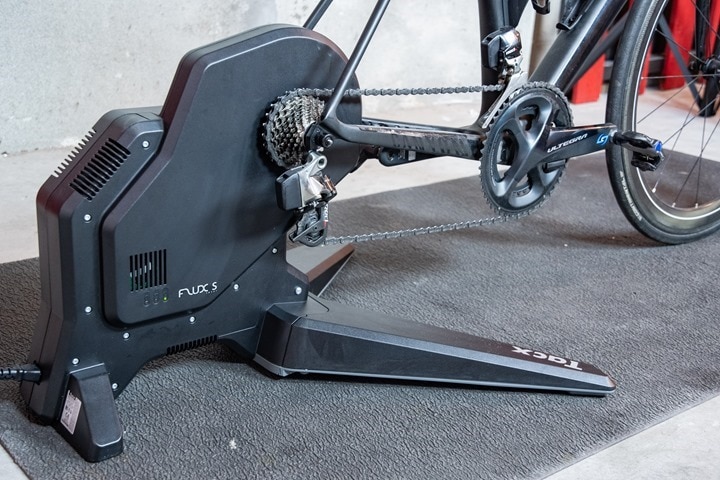
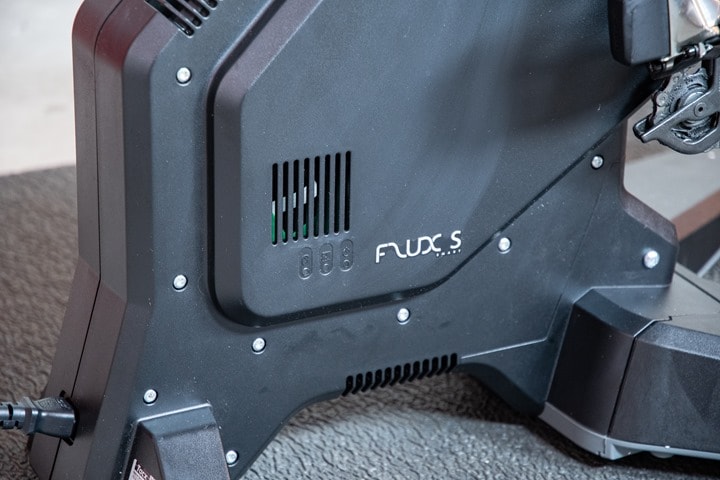

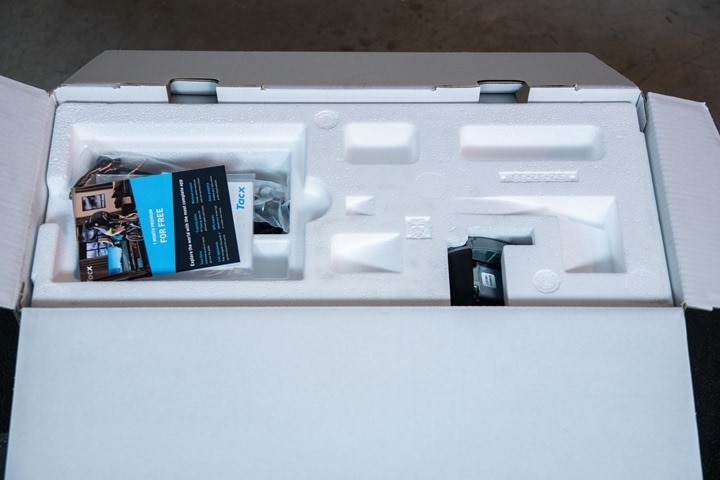
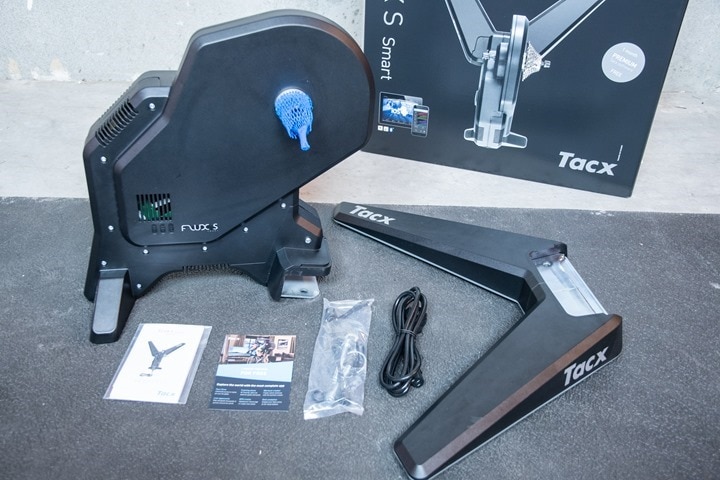

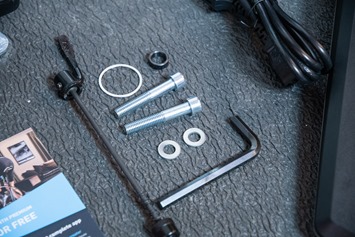
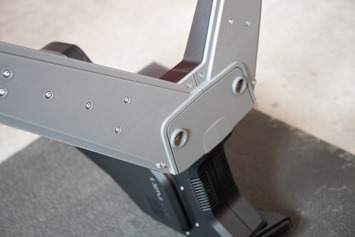
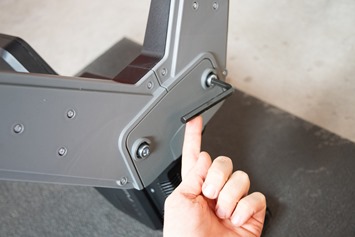
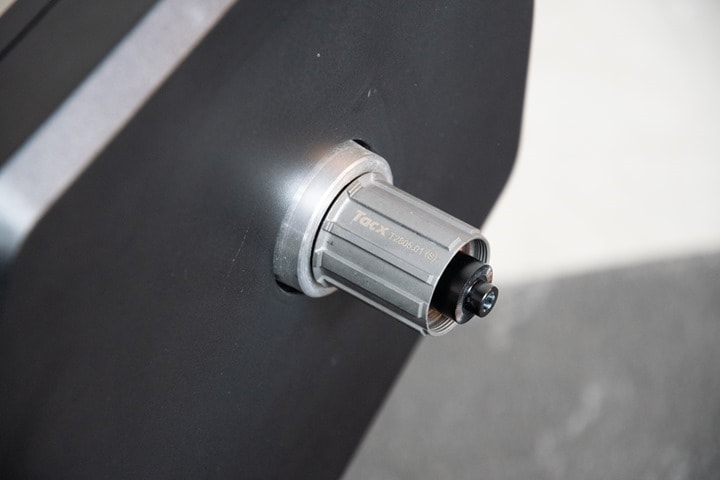
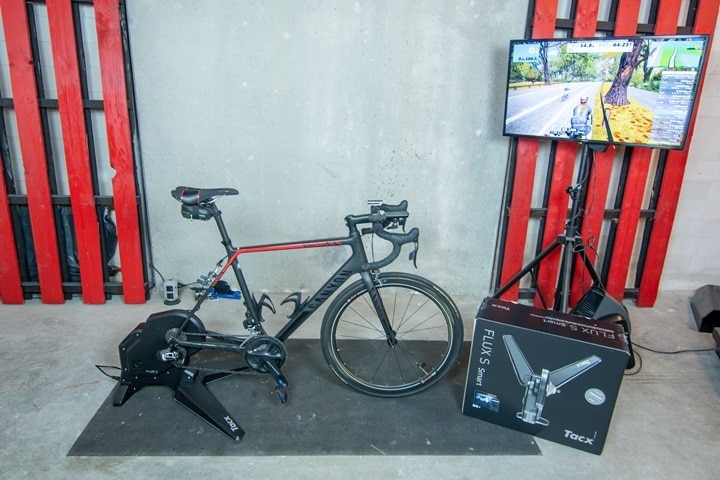
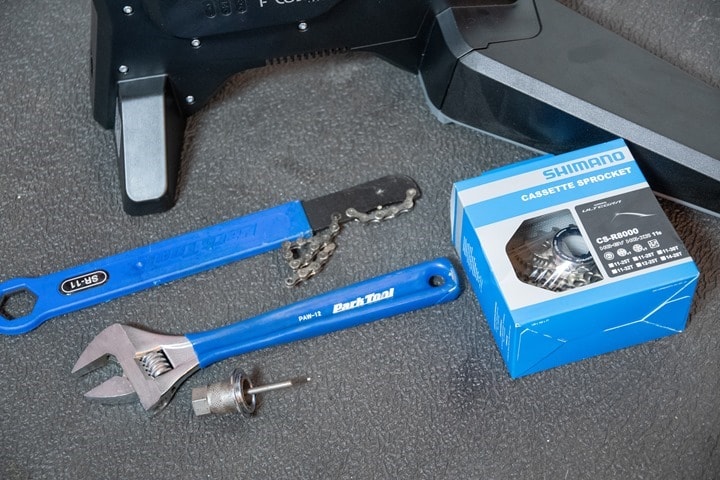
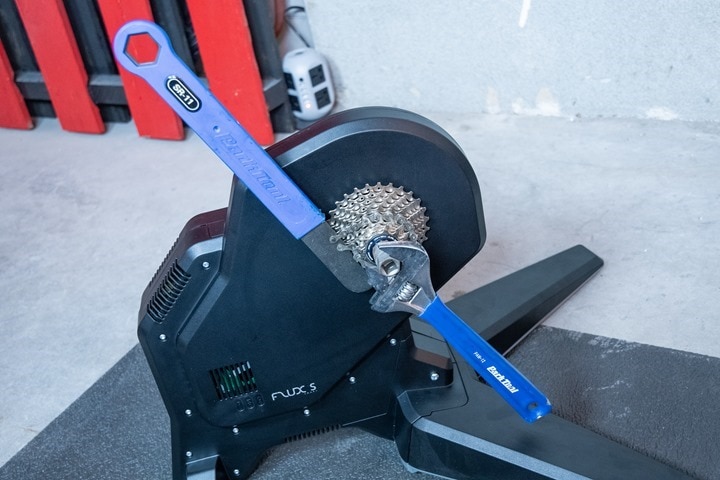
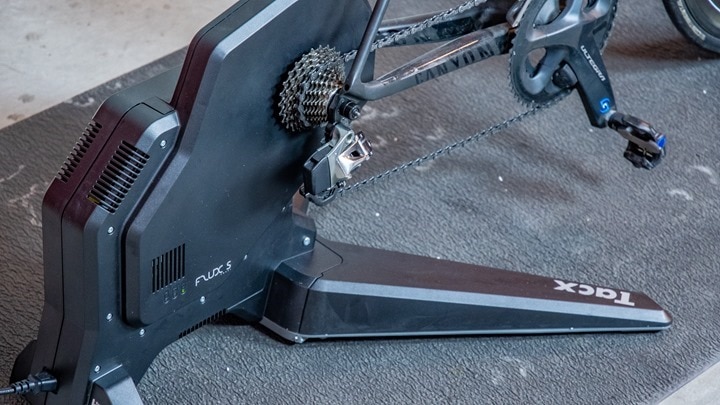
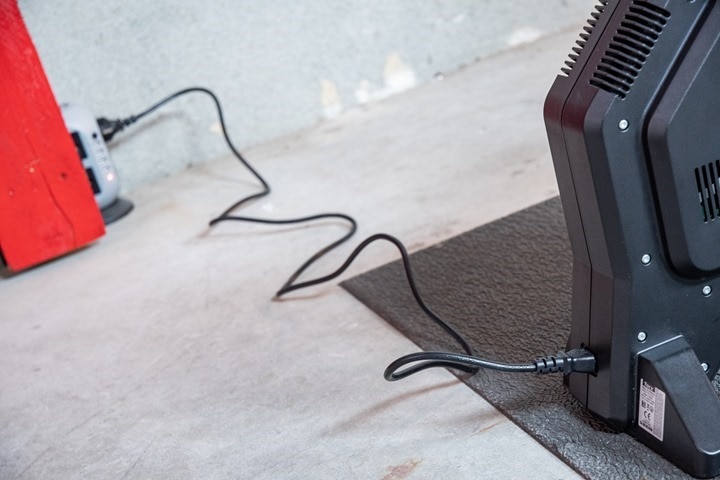
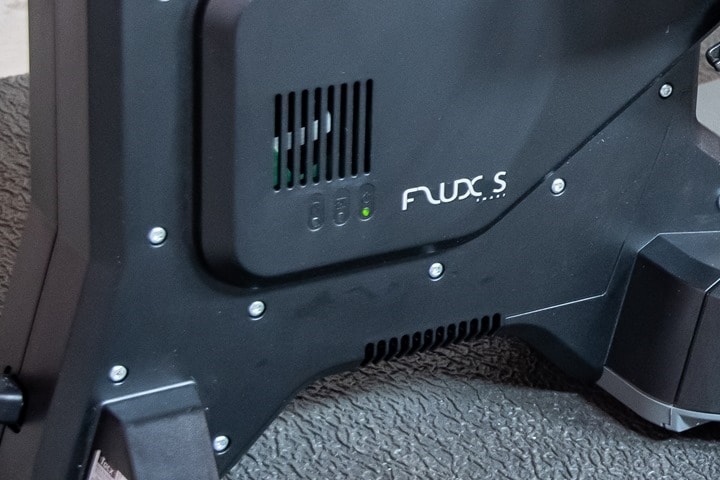
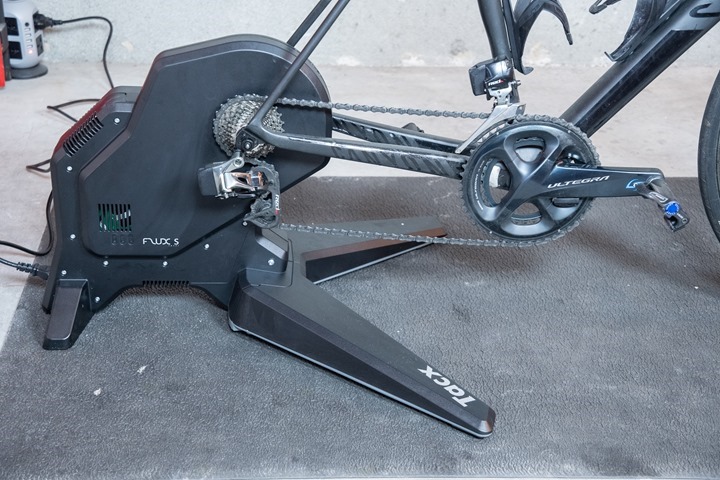


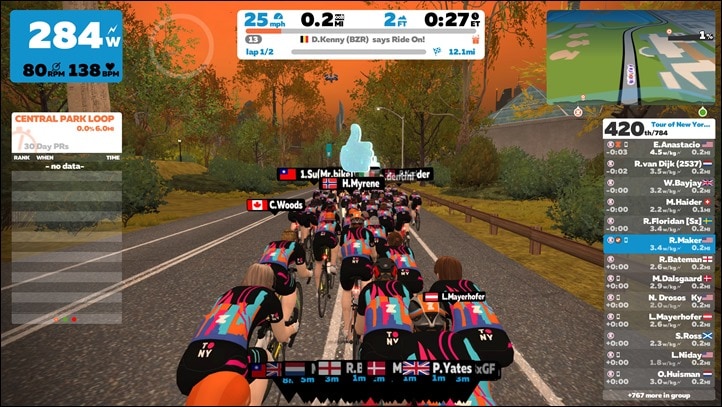
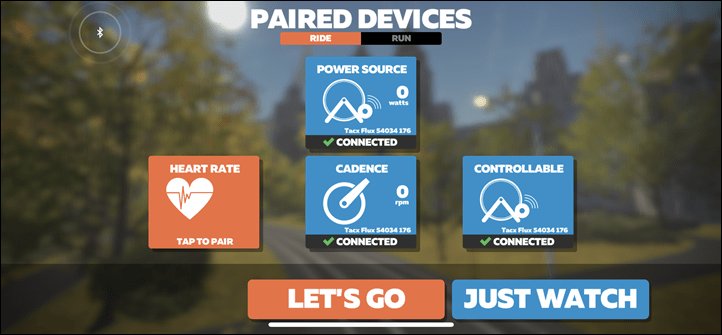
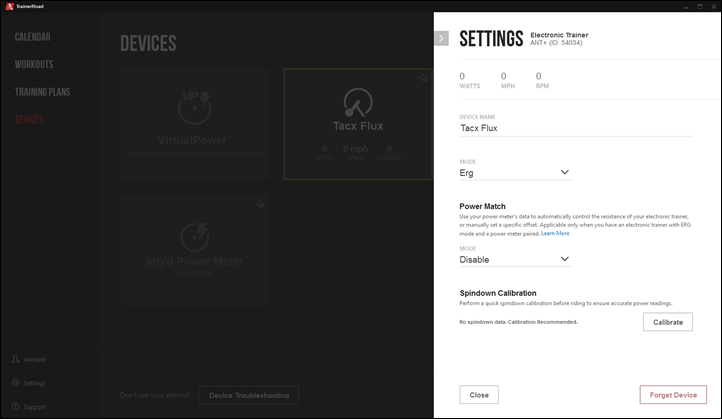
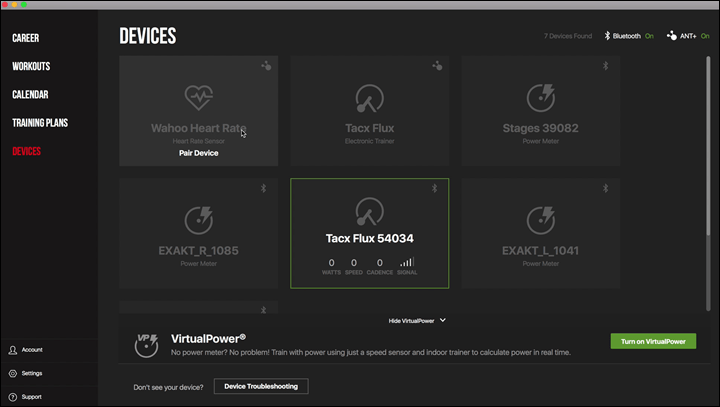
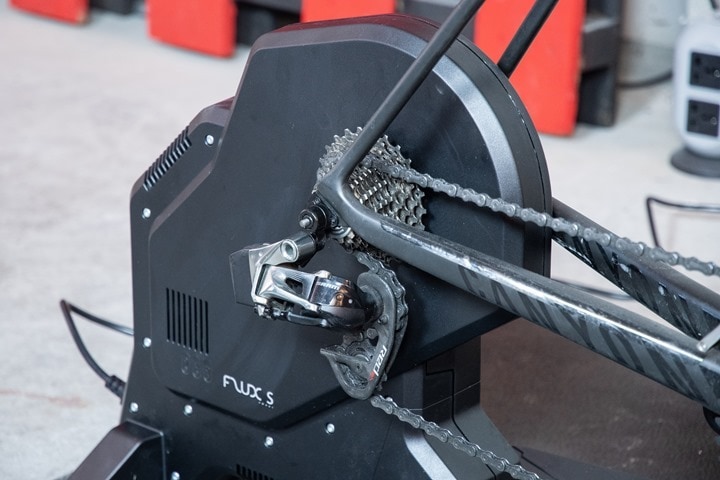
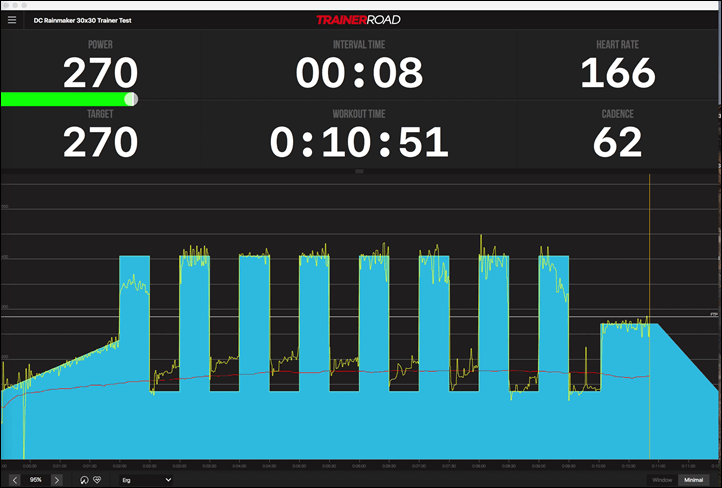
















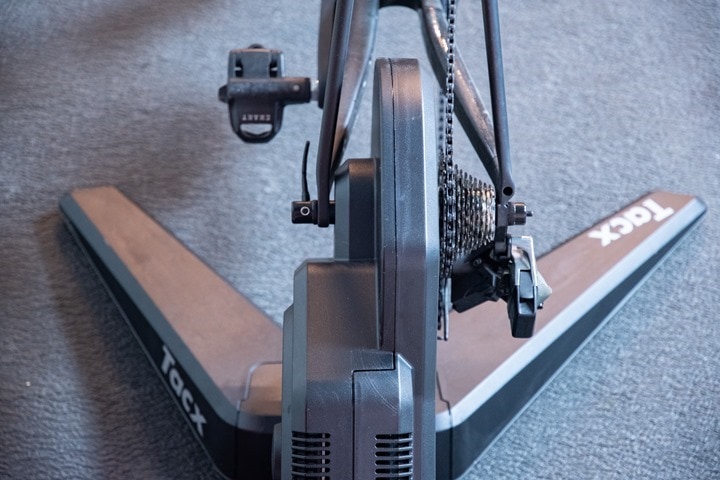
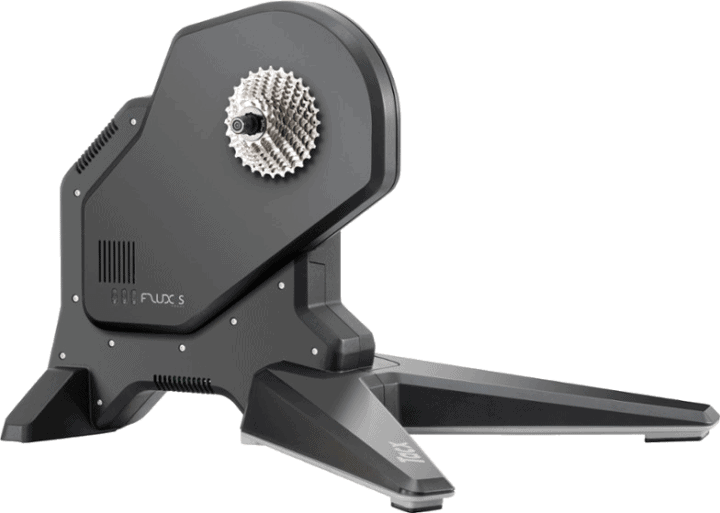




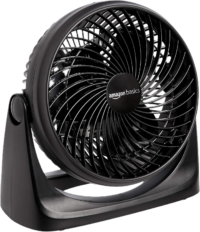
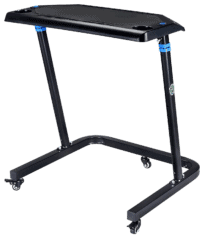
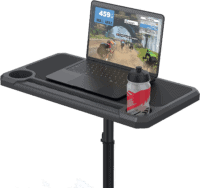

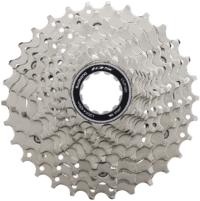
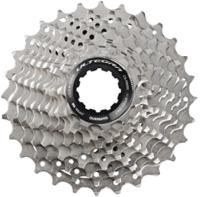
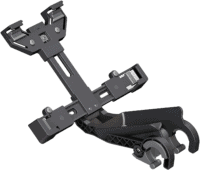





















I had this on pre-order with Amazon UK but no shipment dates yet. The problem is that you can pick up the original one for £450 compared to £549 for this newer one. I assume this isn’t worth £100 more?
I think I will try and hold out until Black Friday and see what other offers are about. £500 is about my max budget really
If you don’t have a long cage derailleur I don’t see any reason to get the Flux S over the original Flux.
I generally agree. Especially since it’s likely that you’d be getting a Spring 2018 onwards Flux 1, which includes *everything* internal that the Flux S has, save the longer feet.
Awesome, thanks for the advice, that’s made up my mind then! Now just to see if I have the patience for BF and see if I can get another £50 off!
I guess you need to figure out if it’s a gamble you can afford to take. I’m not sure what stock levels are like of the Flux and it’s another month to go. You might save £50 on one, but it might cost you £100 if you miss out.
Half full: Apparently no special QA/QC on the units they ship to you. ?
Half empty: 50 percent failure rate. ?
True on #1. Someone on YouTube commented that it was poor that Tacx didn’t do a special QA/QC on the initial unit they sent me. I’m actually glad they didn’t. It shows that they aren’t trying to game the system by ensuring everything that arrives is perfect*. Sometimes crap happens, and perhaps this is one in thousands, or perhaps it’s more. Hard to know. But I’d rather a company just pull a random unit off the line and ship it out to me than something super special.
*It’s actually funny, lots of people assume that most units that reviewers get are special…but in reality most times we get crappier stuff that regular people get. Usually hardware/software bugs aren’t worked out, manufacturing isn’t up to speed yet, etc.. Linus Tech Tips on YouTube did a really good video earlier this year on it, in relation to computer processors sent to reviewers (which YT search is currently not finding for me).
As my old econometrics prof would say, a random sample of 2 is unbiased… it’s just not very precise ?
Maybe you aren’t high enough on the Totem pole yet to get the “Ferrari treatment” (Ferrari is famous for sending cars that have been “double checked” before they are reviewed)
They’re worse than that. They don’t just check over the whole car before they give it to you. They send a whole team to set the car up for the specific track and only let you drive that specific track.
Oh, and don’t bring any other cars to do side by side comparisons.
Looking forward to this year’s trainer recommendation guide, helping me picking my new trainer. Is there an ETA for its release? Thanks Ray for such valuable information and your expertise.
I had slatted it for Wednesday (tomorrow), but it appears I’ve got back to back trainer announcements the next two days. So, things might slide to the day after that to account for these.
Awesome! I too was wondering when the latest trainer update was going to drop. Looking forward to reading it soon….
A question about simulated grades: Does this trainer (or smart trainers in general) take rider weight into account or just assume that the rider is in the 70 kg range? As a Clydesdale, I am all too aware that it takes a lot more power to maintain the same speed on a given incline than my lighter friends. I have a Cycleops Fluid 2 that runs out of resistance at low cadence with a 50×11. Wondering if I’d find the same with this and if I should opt for the S model.
Thanks.
As a cycling Mammoth who used trainers from bkool (classic and Pro) and Wahoo (kickr V3 and currently on a V4) I can say that the simulated slopes are based on a 70-75kg rider, usually.
I could never get the bkool units to get more resistance over 6% slopes for my heft. Wahoo kickrs are kicking my arse though they still max out, for me, at a lower point than the claimed max. There is no way I could ride a 18% slope with the power I have at my weight. But I can and have done on several software platforms with all 4 trainers. It is the software that works out the resistance levels for the input weight.
Having said that the erg mode in workouts on the kickrs will have me grinding to a halt if I fail to maintain the correct power for the required duration in workouts.
Although none of the trainers will give full claimed slope for the over 75kg riders IME. The resistance they go to will, usually, be more than enough to give you a good workout. As you weight goes down the relative max slope will go up.
Thanks, that’s pretty much as expected. I wish I could get weight off. I’ve gone down a size for both jersey and bibs, but weight has remained the same this year. Yes, I’m faster on the flats, but as soon as it turns uphill for more than a minute, @$%#!
Check into Keto Diet (albeit not for everyone). I’ve dropped 30 Lbs without counting calories, feel better and more energy.
Thanks, Casey. Unfortunately, I’m one that Keto fails because I do so much time above threshold. I live in a pretty hilly area, even my “flat” ride includes a .25 mile 12% climb to get back home from the river. On that I am above threshold to keep from falling over. Even at 3% I’m often above trying to keep up with friends. Yes, threshold has been raised recently, but I still need to get it higher before I try Keto again.
“since Wahoo heavily restricts discounting…”
Pro-tip — attend the events at local bike shops. We had one last month in Ohio — if you suffer through Wahoo’s product demo/sales pitch, you can place the order for 10-20% off depending on volume. Got me a 2018 KICKR for $960 pretax.
As a bonus, there’s real human and community interaction versus the soulless ecommerce experience!
Do they have a list of events somewhere? I can’t find anything. I’d go sit for 10-20% discount.
I checked the Wahoo website and was never able to find a list. They also never posted it on the Wahoo FB or Twitter. Doesn’t seem like Wahoo aggressively promotes these, which is an odd marketing approach.
The local bike shop DID post to Facebook ahead of time, so I believe your best bet is to stay close to your local bike shop.
what kind of remote control you user for Zwift?
use for Zwift in the video?
All the parts where I’m in the kit are with Apple TV, so i just use the Apple TV remote.
The actual recorded clips in that little Montage were from a Zwift session I did on my iMac 5K a day or two later.
Can you better define longer derailleur cages?
Do you mean RD-R8000-SS vs RD-R8000-GS? So GS rear derailleurs won’t fit without the longer cage support? (the road derailleurs that go up to 32/34 teeth on the big cog) Or is this more for mountain bike derailleurs that can handle a cassette that is much wider?
Eli, I think the term ‘long’ can be misleading as I think generally Shimano have recently just called them ‘short’ (SS) and ‘medium’ (GS)? On my Flux v1 a Medium 6800 cage does catch the legs, but just means I can’t use my 28T (which I generally don’t require anyway, AdZ isn’t that steep!). I’m unsure if the Shadow tech of the R8000-SS means it drops low enough to snag the Flux v1 (unsure if it drops lower than the 6800?). I wouldn’t expect it to. Although my RD-6800-GS does snag the leg it still goes in the 28t (doesn’t snap the cable) if I do it by mistake! :)
I wonder if the Flux v2 legs will fit the Flux v1 unit, Ray is it the legs the changed or the mounting of them to the unit? I imagine it’s such a minor design change that they would only change 1 of the parts. Ideally the legs, so they may be able to retrofit to the v1?!
Re Connectivity – I was stumped by a fairly basic problem recently which some of your less technically minded readers, if any, may also find. I have the 2017 Tacx Flux and a newish Windows PC, Zwift subscription and an android phone. I thought I would be all set but when running Zwift I couldn’t get the PC and the Trainer to work together although they were paired. Zwift support desk were helpful and their solution is
“Your TACX flux does indeed transmit information over both ANT+ and Bluetooth protocols. However, the Zwift program for Windows does not support native Bluetooth. To connect your trainer to Zwift on a Windows computer you will need an ANT+ dongle…..
You can also use Zwift Companion (formerly ZML) to connect your bluetooth devices to your PC over your home network.”
The Companion solution works easily and is a fine workaround without having to spend any extra money on the dongle.
Another awesome review, would it be impolite to make a suggestion, on your graphs can you keep the same colour for the device you are testing throughout all the graphs, it just make sit easier to follow.
Yeah, it’s been on my to-do list. It’s slightly challenging in that each set is considered a different data set – so all coloring is unique per set. I tend to re-use sets across multiple reviews. So in the case of this for example you’ll see some of this same data on my SRM review soon. And of course that has other sensors outside (like my PowerTap G3).
Becomes a complicated and interconnected web. Perhaps the solutions is making umbrella groupings and then being able to make all devices the same coloring within that specific umbrella. Definitely something to figure out.
I’m still not sold on smart trainers.
For mine, nothing wrong with a good, quiet fluid trainer (e.g. Turbo Muin 2) and a power meter on your bike.
Would far prefer to ride to a Trainer Road plan and watch a film, explore new music or browse youtube than go around and around the same course.
Robert, have you tried these newer smart trainers? I used to ride rollers, but since I got my first smart trainer, I never rode the roller one single time again! That was 8 years ago. Any smart trainer is a brand new not-annoying training world.
DC, I have found that Tacx is releasing a Neo-2, with part number being T2850.
link to rosebikes.com
Do you have any news on it?
And the current Neo can be bought for €990,-. link to bike-components.de
Neo 2 on Rose now has pictures too. Team Sky edition? lol
I have probably missed some comment on it, but do you have a recommendation between the Flux S and new Elite Zumo? Other than $50, what are the pros and cons.
P.S. The Flux S, which uses long cage deraillers, I would presume would work with a 1x gravel bike, giving you that option. How about the Zumo?
I noticed when putting The Girl’s bike on the Zumo today that it was a bit finicky with her longer derailleur. Once it was on, it was fine, but the act of getting the bike on was cumbersome because of it.
Spec-wise they are super similiar: link to dcrainmaker.com
Practically speaking I feel like the Flux S has better road feel, which isn’t surprising given it has a bigger flywheel.
Thanks Ray! Exact answers that I needed. You’re awesome. I will assume that moving from a Tacx Vortex to either one will be a huge upgrade for me.?
I think it would be pretty solid.
Question for Ray and others: How much of a limiter with the 10% grade limit be while using Zwift? Like what exactly happens when you are on a Zwift climb that is above 10%+? The price seems right on this for me but I’m bummed about the 10% limit.
It basically doesn’t reflect above 10%. Realistically any incline at 10% with 100% trainer difficult is pretty challenging.
Did the internal changes over the first models also improve accuracy/make a warm-up unnecessary or is Tacx now just stating the after-warm up accuracy?
In your original Flux review you wrote:
“Tacx has officially listed the trainer at +/-5%, which is on par for wheel-on trainers in the $500-$600 range (i.e. KICKR Snap, Tacx Vortex, CycleOps Magnus, Elite Rampa). But they also caveated that if you exclude the first 10 minutes during a warm-up period, then the accuracy would actually be closer to 2-3%, which is on par with those $1,100+ trainers I mentioned earlier.”
Yes, about a year after the original Flux came out they increased their accuracy claims (based on software updates).
In general, I’m not seeing much issue with temp drift on the current Flux units (or for that matter, really any other direct drive trainer these days).
Also had that quacking sound from the inside of my Flux, a v1 (T2900), bought earlier this fall. Unclear if with updated internals or original model. Tacx support suspects the noise to be caused by “the belt that has skipped from the roller”. Was asked to return the trainer to the dealer for investigation, so it will be interesting to see what happens, if some kind of repair will be done or the trainer will be replaced. The dealer does not however stock the old Flux anymore, and my thought was that the noise would be gone for the Flux S, but apparently there still is a risk for ducks for the S…
And as always, thanks for the exhaustive review!
Hello!
Do you have a date for test the Flux 2? I decide between the Kickr Core and the Flux 2-
I haven’t received one yet. :-/
Thanks for your great tests. I think it would be interesting for heavier riders which trainer at 10 km / h how much slope creates. This is the property that determines my future purchase.
Great review .I can get the flux smart for a good price but bearing in mind all the issues that it had would it be worth skipping it and just go for the s
Honestly these days I just don’t see the issues happening on the original Flux series. And remember, the Flux S is the same unit, just with a different frame mold.
So basically, I’d go for whatever you get the best deal on that fits your bike.
Great thanks for that decision made ?
I had my first go on this today, I was previously using a tacx flow, this was also my first time using a direct drive trainer.
I was very disappointed with it, I used it with trainerroad in erg mode. Erg mode really struggled to maintain consistent power, on the flow I would by big ring at front and middle of casette, but with the flux this gearing was hitting about 15 watts above my 220 target in erg mode so was forced to change gear. For recovery intervals I had to drop into my lowest gear as any other gear combination would be much to high. With the flow I never had to leave the big ring.
The power graphs were very erratic compared to the flow which is super smooth, I also found the work out much more difficult compared to the flow despite the workout not going above my ftp.
Is it possible the power readings are wrong? I’m going to put my good bike with power meter on both trainers at the weekend and see how they compare but at the minute, I feel like sending it back.
Any thoughts on this?
Try switching to the smaller ring in the front, that’ll help responsiveness (it’s also what TrainerRoad recommends for ERG mode).
The interval on the left is in the small ring, one on the right is big ring.
Either way the whole experience just felt wrong compared to the flow, which had no issues in the big ring. It could be a case that the flow has been wrong the whole time but it feels from a power point of view more realistic.
So decision time do I go tacx flux 2 at £439 or Wahoo Snap at £499? Just want reliability and erg mode. Plus I will need to pack away after use. Thoughts please.
Wheel off trainers are better but that one doesn’t really fold for packing
I’ve just collected a new Flux from Halfords for £360 – happy days :-)
Have you had any issues with it or is it all good. Cheers
Only used it 3 times since I got it on Sunday but excellent so far. A lot quieter and smoother than the Tacx Vortex it replaced. And a lot more accurate.
Thanks for the review, helped my decision a lot. Have been using a Flow for a couple of years, pretty good but decided to upgrade to direct drive. Some good deals on just now, my 20% platinum discount at Wiggle got me a Flux S for £439, which I reckon is a great buy. Interestingly, have found the power averages for my activities match really well between Flow and Flux S, but there are lots of other differences within that. No calibration, no checking tyre pressure, much less noise, much nicer ‘feel’ to the ride (not necessarily more ‘realistic’, just smoother really). As a small and lightweight climber-type rider, I always found the Flow seemed a bit too hard on the flats and far too easy on the climbs – the Flux S makes the flats more as I would expect on the road, and the climbs are definitely more realistic (I never needed the small ring on the Flow, but I do for the Flux!). I was considering a more expensive direct drive, but having read you review I opted for the Flux S and saved around £300 I reckon – so thanks very much!!
Just received the Flux S unit and starting from the first ride SOMETIMES I can feel a significant vibration which comes out of it. The worse is that the vibration can be felt throughout the whole frame of my bike and can be hears resonate in the floor as well. I’ve done just several rides and at first it seemed to me that the vibration starts at high cadence or speed level. Yesterday, while performing a session in ERG mode, it seemed that the vibration starts when the power has been increased rapidly (for example, lowering the gear and pushing the pedals in full wright from the beginning). It didn’t occure if the start was performed in more gentle way. So, it’s still the subject for further observation: ).
In generally, I’m satisfied even with this minor (or maybe not) issue. However, the formal response from the Tacx support centre was – Vibrations will only occur if there is something defect on the trainer or if your bike is not set correctly on the trainer; please check your setup and if everything is tightened correctly. Because of that I would like to know whether there is anyone else who have experienced the same issue and could comment what is the main reason for that. Should I sent the unit back (as it’s actually suggested by the Tacx support team) or maybe my expectations are simply far beyond the trainer’s ability to perform. Again, the overall performance is great but this small jumble is at least annoying.
Just had a look at the Tacx FLUX Facebook page and there’s still loads of folk having issues with them I’m begining to wonder if I’ve made one almighty mistake
I had a Kickr Core for one week and then it stoped working. Then i have read all the problems with klicking sounds, stickers flew off, and the problem that i had. So i gave it back and orderd a Flux 2. Now i read all the Problems with the Flux and Flux S. A Friend have the Elite Direto so i read about that trainer and there also problems with Sound and Belt. So either there is no trainer in this price range that works fine or it’s just a small part that’s having trouble with it and everyone else is not writing that they’re happy.
Maybe i should have stayed with my BKool that cost half. Lets see :-S
trainers may be like computers… for every make and model there are reviews about how the purchase ruined there lives.
Hello Ray,
is there a difference between the Flux s and the Flux 2 regarding the issue you called “resistance floor”?
Today I did my first ride on the Flux S and the trainer wasn’t able to control a power below about 150W with a pedaling frequency of 90 and a gear ration of 50/23. With my Neo I have no problems to control e.g. 80W with this gear ratio?
BR Rainer
I have a new Flux 2 and can try it for you if it has not already done.
Hello Gary,
that would be really great!!!
Could you pls. try which is the lowest wattage the Trainer is able to control with the big ring in the front and a straight chain line (3rd biggest ring on the rear, should be something like (19,21,23,..)) with a cadence of 90RPM.
Thanks a lot!!!
Rainer
Hi!
Tried it now with 52/25 what is the nearest tranmission on my bike to your 50/23. I had about 68 – 70 Watts at 90RPM, 0% slope and 75kg Bodyweight in the Tacx app. I hope i could help you.
Gary
Hello Gary,
great, this are perfect news!
Thank you soooo much for your effort. The result helps a lot and I will purchase the Flux 2 now!
All the best Rainer
No problem
Have a new flux S struggling to get it to hook up to my edge 520 via Ant + whilst connected to HRM & DZero power meter…. I am riding workouts downloaded from training peaks onto edge 520 need to see heart rate & power….. am I using this all wrong? does the flux give me power data, cadence etc? new to these smart trainers ?
Flux submits power, cadence & speed data via Ant+ and Bluetooth. Use Ant+ If you can.
thanks adrian, looks like I had to much connected to the flux at once (bluetooth to i phone tacx app and garmin via ant+ to hrm and pm on my bike plus trying to connect to the flux)…..
will try later ant + only to flux via edge 520 with no bluetooth/tacx app and only hrm connect to edge 520 also via ant +……
hoping this then ok to crack on……
Only 1 app can control the trainer but multiple apps can receive the transmitted data from the trainer.
I always record data on my Garmin Fenix. If I’m Zwifting then the Zwift app also records the data.
great thanks….. will be using my edge 520 ant+ connected only as this will also have the training file I will follow from my coach down loaded from training peaks…… i can see that i can adjust flux resistance level from edge 520 also if i need to……. training is a mix of HR sessions and Power sessions…… don’t think i will ever use any of the apps….. new to this smart trainer world…..
Cannot despite trying all options get my new Tacx Flux S to connect via ant + to my Garmin Edge 520. Trainer connects ok via b tooth to tacx app and can calibrate etc. Then turn app off and garmin on and go to pair like any other ant + sensor but nope not happening. Have flashing green light for power and solid blue when b tooth connect but to my edge 520 just not happening… HELP…. think may have faulty tacx…. no issue at all with my 520 hooks up ok to all my sensors on multiple bikes…..
Hey Ray, any advice about what’s the better value-price between Wahoo KICKR Core and Tax FLUX S Smart?
I want to buy a direct drive training for my winter biking and those are the 2 best options I have so far.
Thanks
Antonio
It depends on the price. If you find a $699 or $749 Flux S, that’s good. But as it creeps up to $899 (which it shouldn’t, but just putting pricing in perspective), the clear winner there is the CORE. It’s just so much more powerful, especially at low speeds (for climbing).
I recently got an original Flux for £360. Bit of a bargain but it had to go back after 10 days due to squeaking so much for the first 15 minutes. Now on my second one…
I just bought a Tacx Flux S.
I cant remove the original “shimano” body (I will replace it with a campagnolo body). the body is simply like welded to the shaft (I have removed the black cap with a 5mm allen key.)
Have you heard about a problem like this, with the Flux S??
Best regards
Jan
Hi there Ray.
Just one question. What is the point of setting bike weight on the garmin when we pair it tacx flux with the garmin edge?
Wheel perimeter is to compute the speed right?
It controls the road-like feel.
The cadence data is estimated. Can it be over-ridden in apps if you use a real cadence sensor?
Yes, if you pair a separate cadence sensor it’ll override it.
I am in doubt whether the Tacx Flux S is able to produce enough resistance in lower speed situations. Would it for example be possible to produce 400 watt when doing a cadence of 70-75rpm?
I can only find that flux S can produce less power at low speeds, but I can’t find actual numbers. Unfortunately cannot test these trainers closeby.
Hi Casper,
I did some testing with Flux S back in October w/ low cadence 1 minute intervals on ERG mode. Its quite demanding for ERG mode to keep up as the cadence was so low.
ERG/NP/AVG/Cad
292/277/276/49
329/313/309/56
365/349/341/45
402/384/374/52
438/407/400/50
475/457/442/48
511/472/454/42
548/505/487/43
Thanks for the table! Can I conclude from this that it is struggling but does come close in low cadence? If this is output at cadence of 50 or below, probably at 70 it will be fine I guess? I don’t really like cycling below 70 anyway.
Or am I misreading your table?
I did my testing with 52-12 gearing. TACX has published Flux S power area on their support pages. The graph is showing resistance area with 39-19 gearing. To “move” the area, you need to change gears – my table is kind of showing the maximum.
link to support.tacx.com
How does the noise level of Tacx Flux compare to a Tacx Neo and a Stac Zero? Why?
I need to find a trainer I can use when my partner is sleeping
Thanks!
The Flux is the loudest, then the Neo, then the Stac Zero. The Stac Zero is the quietest trainer out there.
But why? The Stac has a ”large” wheel with spokes whipping the air. Direct-drive trainers only has a piece of solid metal rotaring in special built chassis. In my logic, that should sound less than a big wheel spinning fast?
Would be great to understand the logic
Thank you!
And how much is the difference really? Any way to “quantify” or put in relation? Just to know if it is very slight or very significant difference. I have been trying to read up on decibel measures, they seem similar between Flux and Neo, but have not found for Stac
It seems that this trainer isn’t compatible with my Tarmac SL6 with a standard 130mm axle. 5 mm spacer included is too long. Without spacer left chainstay touch the trainer.
I also have a Tarmac comp SL6 2018. Do you really have a problem with Tacx Flux S? I was ready to pull the trigger for the order but your comment makes me thoughtful!
Hi Ray, Thanks for all the reviews. Except it makes for a much harder decision with all the details :0)
Question to you and whoever else wants to chime in. I am upgrading from a Tacx Vortex to either a Direto 2 for $689 USD from a US retailer or a Tacx Flux S from Europe for $528 USD + 20 USD shipping. I like to race on Zwift, but I feel like I’m cheating on the vortex and want to upgrade.
Do you think I’d notice much between the Direto 2 or the Flux S for lag? Also is the accuracy really that much better on the Direto 2? I currently don’t have a power meter so I can’t swap that in for power readings. I’m just thinking I’d be able to get a cassette and a nice set of tires with the Flux S for the same price as the Direto 2.
It will be easier to justify to my wife the lower cost, but that’s not the end of the world. I like sleeping on the couch ;)
Cheers
Is it possible to ride a GPS route on the Flux S controlled via a Wahoo Bolt head unit ?
Yup, pairs as a standard ANT+ FE-C trainer.
Many thanks – I have been struggling with a Garmin 820 headset which seems to apply huge resistance for even slight inclines (1-2%) on re-riding routes.
I have reduced the rider weight on the device but doesn’t seem to make much difference.
Will see if the Bolt gives better results.
Honestly, the challenge with either head unit and re-riding courses is the variability of the data. It’s something that sounds good in theory, but in practice doesn’t usually end up being super awesome.
Most outdoor ride type re-riding indoors solutions usually smooth the elevation data quite a bit to get it to work.
Point taken and thanks for your advice.
I have since tried the Tacx app with a GPS route, which as you suggest applies a fair degree of smoothing, however it does provide a much better experience for me.
Hello!!! Noob question, Please forgive me… I have a 105 5800 11sp 11-28T cassette on mi bike… For a strange reason I couldn’t find the same in all of the stores I visited, but find a 105 5800 11sp 11-25T. Can It do the job? And what difference can I expect? I buy The flux s and I don’t want to wait 3 weeks unless it is a very bad idea. Thanks in advance.
hey guys – so – bottom line – flux s instead of flux 2, is that correct? ;-) or one should not even consider the current flux series and go for a neo 2?
thanks,
tudor
First of all, thanks for your reviews. They’re the best, most detailed and engaging ones out there by a country mile.
Since this Tacx has room for a long cage derailluer I was wondering if the Kickr Core will also allow for one. And for that matter the Kickr Snap and Elite Direto.
You can probably tell from the question roughly what my budget is (in a Black Friday sale) and while I’d rather have a direct drive trainer, the Snap seems to be the best of the wheel-on versions.
With that, do you find it a pain to recalibrate it havinf first done a 10-minute warm-up?
Thanks.
Kevin again.
I should add that I use an 11-32t Shimano Ultegra cassette normally (I’m a spinner) so I’m only really interested in trainers that accommodate them and I’m a little unsure of what Tacx mean by long cage as I think cages are only branded as short and medium these days.
i have a snap and had a long conversation with Wahoo about its calibration. My takeaway is that, if the bike and snap aren’t moved and the room temperature hasn’t changed much, pump up the tires to 110 tighten to 2 turns off the knob and you’re good to go. i calibrate mine once a week or so but I’d do it prior to a race or ftp test when you need the highest accuracy.
Drew Z (Wahoo Fitness Support)
Nov 8, 3:48 PM EST
Hello Steve,
We recommend before every ride with the Snap for best results as the power will not be as accurate but if you are just looking to get a workout in you should be fine doing it once a week.
Thank you,
Drew
Milwsaw
Nov 8, 2:11 PM EST
Hi Drew,
Excise me for being a little slow but I’m trying to understand this so that I can optimize (keep to a minimum?) my spindown since I’m a 4AM (before work) Zwifter.
So… The Snap is setup to work just fine at 110psi and two turns off the knob if everything is in good working order. It sounds like you’re saying to do the spindown to make sure that the resulting time doesn’t vary much from what you’re accustomed to seeing because it would signal a problem with either the bike (that beach ride wasn’t good for the back bearings) or the Snap itself. Is that correct? If so, I wouldn’t bother doing a spindown before every ride… Maybe just once a week.
Thanks for your patience
Kevin again. With a new thought.
I should add that I use an 11-32t Shimano Ultegra cassette normally (I’m a spinner) so I’m only really interested in trainers that accommodate them and I’m a little unsure of what Tacx mean by long cage as I think cages are only branded as short and medium these days.
11-32 & 50-34 combo all work fine. Shimano GS rear (=med / long cage) has no issue given the Flux S redesigned body.
I there nice work bu the way, keep doing what you do.
Just one question if you can help me, wich one would you choose the tacx s or the elite turno thanks.
Easily Tacx Flux S.
Thank you and keep up the good work ;)
Got ones of these as a replacement for my Flux original that i sent back to Tacx for repair.
When sending back the old one the instructions were to remove the freehub body which i did, but when i got the new trainer back there was a freehub body attached – T2875-01 which doesn’t seem to have any place to screw in the edco cassette lock ring.
Notice on the picture above that freehub body shows T2805.01.
I tried to swap the freehub body, but looks like the axle you put it through has got thicker between the two models so it doesn’t fit.
Any ideas..?
Hi there,
maybe someone with a Tacx Flux / Flux S can help me.
Ray mentioned, that “it does need power (110-240v) to provide any meaningful resistance.”.
My Flux does provide some meaningful resistance, even when not plugged i, I would say. So, for example, when I pedal at 24kph (flywheelspeed) I have 150W resistance (that is still on small chainring, goes further up with higher speeds obviously).
That leads to some problems:
-I can’t get that feeling of doing a downhill and spinning a high gear what you would usually have on a smart trainer (I guess?) – it feels just like a dumb trainer in these moments
-I don’t have a lot of inertia because in most scenarios, I don’t have a fast spinning flywheel (which is not the heaviest anyway)
-In ERG-Mode I have to shift quite often, because I have to be in a low gear that the inner resistance doesn’t exceed my target power, with such a low spinning flywheel, the trainer can’t add a lot of resistance via the magnetic induced resistance.
I owned a Kickr Snap before. With that trainer, I could simply run an entire workout in the big ring. That’s basically what I wanted from the Flux…
Is that inner resistance normal or do I have a problem? Can you spin out your biggest gears on downhills in sim-mode and/or when unplugged?
Many thanks in advance!
Hi Danny
I don’t think this trainer has downhill simulation?, I believe smart trainers need an in built motor for these and only the top end Neos have that function?
As for ERG I’ve managed well on the small chain ring and somewhere around middle on the cassette with 200 watts for sustained periods of times.
Help me now, wanted to purchase in the next few days- elite suito or tacx flux s or core?
Currently I can’t recommend the Flux S due to some issues I’m having – one of these being the same one DCR has. I did just post a comment about my experience with the unit, however it has been removed, I don’t know if this until it is mod verified.
Anybody else ever had their drivetrain continue to move when you stop pedalling? This is happening to me and my chain comes off if I stop pedalling or slowdown using this unit. I’m hoping it’s something I’ve done, but the installation is pretty easy.
This is the second unit I’ve had to get because the first one sounded like an angle grinder.
Hi,i would like to ask if the flux is compatible with a mountain bike…??
Thanks…!!!
I weight about 115 kgs, wo. Plus bike, what’s the weight limit on these things? Ray?
Brand new Tacx Flux S from Wiggle arrived yesterday. Have a major problem. In ERG mode, all is fine. On slopes 4% and above, all is fine. However, in “normal” mode (e.g. riding the 2020 World Champs course on the Tacx app), anything over 200-220W on false flats, flats or descents induces an almighty vibration through the whole bike – it’s like riding a washing machine on spin cycle.
Tacx (well, Garmin) have said they’re not sure and to send videos of the unit vibrating, which I’ve done. I’m not sure the videos capture just how strong the vibrations are, because they’re not hugely noisy! However, I thought I’d ask here on the off-chance anyone has any suggestions or wise words.
Here’s what I’ve tried: 2 different cassettes (one 9 speed with spacer, one 11 speed), 3 different bikes (2 x 9 speed, 1 x 11 speed), 2 different mats, moving between garage and kitchen and back again (garage is concrete floor, kitchen is wood laminate.) Quite frustrated really – have lost hours trying to troubleshoot, but I’m coming to the conclusion that it’s not me, but the trainer!!
[Incidentally, long time user of the site, very rare poster… I remember buying my 310XT based on Ray’s review, back in the day!]
Update: after another phone call with Tacx/Garmin (they have a call back system that is optimistic with its estimates times, but ultimately effective ?) I was given a fault reference number and told to ship it back to Wiggle.
Packed it up, tracked everything down (spacer, vouchers etc!), took it to the collection point at the local Asda, job done. Email from wiggle about 5-6 days later saying a refund was coming my way, which hopefully will show up soon.
It’s very slow and ponderous dealing with Wiggle (no phone service, and their chat function is a little buggy, so it’s emails all the way) but they’re basically pretty decent.
So… the Flux S experience was not a great one, but at least their customer service was relatively responsive and the retailer took it back without fuss.
Just got a Flux S from a recent production run and it is making that same weird sound Ray experienced. I guess they didn’t make any QA changes, or decided they don’t care.
I’ll reach out Monday to Tacx for support. I’m not really interested in shipping this somewhere or waiting for a replacement so hopefully the answer is that they decided it isn’t detrimental to the trainer and the extra plastic wears down eventually and the noise goes away. It doesn’t seem quite as loud as what Ray had, but it’s clearly the same noise (thanks for the two recordings in your video, Ray!)
Same here – got one from REI in Dec 2020 (picked it up in the first week of Jan) and same “whump whump” noise. Bryan I’m interested to see what you heard from Tacx (aka what I should say to them to get the best resolution).
Unreal that this was a known issue years ago and still showing up.
Garmin Support’s solution wasn’t acceptable. For my defective, brand new unit, they offered me a refurbished replacement (since they don’t have any new Flux S units in stock). Or they said I could pay the difference to get a new Flux 2. For the price of the Flux 2, I would have gotten a KICKR Core, so that wasn’t going to fly.
I called Back Country, who was awesome. They sent me a new unit via rushed delivery and paid for the return shipping (without making me ship back the old unit first). They’re great. I’ll definitely buy there again.
I am thoroughly disappointed with Garmin’s support yet again. When you ship something defective, with a problem that’s been known for years that you claim you already fixed, I think you need to stand up and do more. They should have offered me a new Flux 2 if they had no new Ss in stock, not made me pay for it.
That’s just my sense of it. I’m seriously wondering what I’m going to do when my 5+ breaks, and if I stay with Garmin. If the Apple Watch was more fit for training, I’d move there (tried it for 2 weeks, and it just didn’t cut it for me).
I do know that, when I end up getting a smart bike trainer, I will get a KICKR Bike. I was leaning toward the Neo Bike, but I can’t risk it with Garmin anymore. You should have seen how awesome Wahoo was with my original, 2013 KICKR when it died in 2020. Even though it was LONG out of warranty, they tried all kinds of things to help me, and offered me a discounted refurb new KICKR even though they didn’t have to. I had to beg Garmin to even make a half-effort to stand behind a brand new unit.
And, of course, the rep had no clue about the problem (I sent him Ray’s video, but it took 3 emails until he actually watched it). He kept on things like, “wrong skewer,” “wrong axel size,” etc, etc.
Thanks Bryan, I appreciate the follow-up. I bought mine from REI so I grabbed a new one and (provided it doesn’t have the same issue) will return the first (since they don’t do “exchanges”). I’ll report back on if the replacement doesn’t have the “whump whump” issue.
For what it’s worth, in my experience Garmin support is WORTHLESS via email. My wife’s Vivoactive 3 had a defective barometric altimeter and I sent a long, detailed email with the symptoms, what I had tried already, etc. and they sent me back a link to a product support page for “how to calibrate your altimeter” (aka “wait 30 seconds after GPS lock”). I called them and after a very pleasant 5 min call with a very knowledgeable staff person they had a new device shipped out to me despite the VA3 being a year or two out of warranty.
When the 7.40 firmware killed the battery on my VA3 (known issue affecting certain production run) the same thing happened, I called them and they had a new one sent out (out of warranty) no questions asked.
So TL;DR – call Garmin (and assume that their email is basically run by a keyword bot).
Agreed. If you’re persistent, you can get somewhere via email, but not likely.
I definitely had a better phone experience, but they just don’t seem to be experts on their own products, and don’t seem to have a good knowledge management system their reps can access. The Flux S is a great example where this is a known issue, they changed manufacturing and QA for it, etc, and the guy was totally clueless. Even after watching Ray’s video and hearing what the Tacx team told him officially, they still don’t get it.
Hi everyone
I’m currently using a very simple wheel-on trainer from Elite.
The faster I pedal the harder it gets. That’s it.
To have a more diverse training I would like to change to a smart trainer.
The “Tacx FLUX S Smart-Trainer” would suit me well, I guess.
The bicylce I use on the trainer is quite old.
It has a Shimano 7-speed cassette and a quick release axle with a length (inside-inside, I guess that is what matters) of about 122mm.
In the specs, however, Tacx mentions 130mm.
Does anyone know if there as an adapter, shorter hub, or similar that would allow me to fit my 122mm bike to the FLUX S?
Or would my bike fit anyway, and I’m just not reading the specs correctly?
Thanks in advance for any hint.
I know this thing is really new but I am still driving on it. Eventhough it is as reliable (or unreliable) as it is in the begining when I bought it. I struggle more and more to use it in ERG Mode. I do have the issue that (actually exactly what you describe) it has not the power to control either down or up depending on the gearing. That was in the beining not really a big deal for me but it starts to annoy me more and more. If I do sprint intervals it can not reach the high resistance whitout shifting up but also not go down to the low resistance brakes inbetween the sprints without shifting down. So I am forced to shift all the time. My question would now be, since I did not find similar charts is the flux line (flux s and 2) the only one affected by this or is that just a budget thing and I need to go for higher priced units like the Neo or the Elite Avanti or Justo 2?
For example if we do compare it with other “low budget” trainers like the super new Elite Rivo, kickr core or jetblack and so on, you get it i guess.
I would highly appreciate the help! :D|
thanks :)